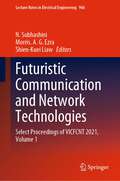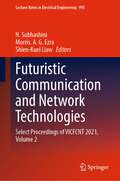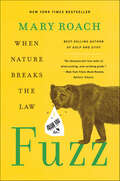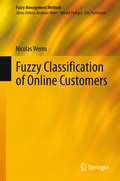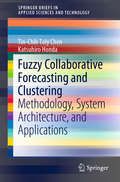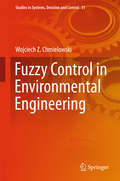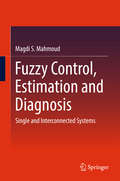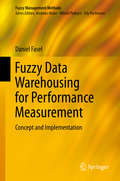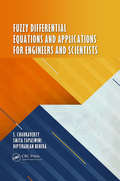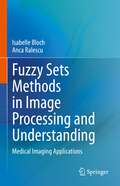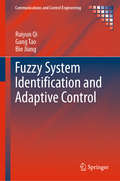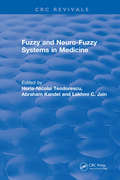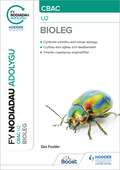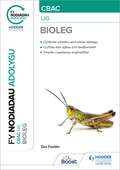- Table View
- List View
Futuristic Communication and Network Technologies: Select Proceedings of VICFCNT 2021, Volume 1 (Lecture Notes in Electrical Engineering #966)
by Shien-Kuei Liaw N. Subhashini Morris. A. G. EzraThis book presents select proceedings of the Virtual International Conference on Futuristic Communication and Network Technologies (VICFCNT 2021). It covers various domains in communication engineering and networking technologies. This volume comprises recent research in areas like cyber-physical systems, acoustics, speech & video signal processing, and IoT. This book is a collated work of academicians, researchers, and industry personnel from the international arena. This book will be useful for researchers, professionals, and engineers working in the core areas of electronics and communication.
Futuristic Communication and Network Technologies: Select Proceedings of VICFCNT 2021, Volume 2 (Lecture Notes in Electrical Engineering #995)
by Shien-Kuei Liaw N. Subhashini Morris. A. G. EzraThis book presents select proceedings of the Virtual International Conference on Futuristic Communication and Network Technologies (VICFCNT 2021). It covers various domains in communication engineering and networking technologies. This volume comprises recent research in areas like cyber-physical systems, acoustics, speech & video signal Processing, and the Internet of Things. This book is a collated work of academicians, researchers, and industry personnel from the international arena. This book will be useful for researchers, professionals, and engineers working in the core areas of electronics and communication.
Futuristic Sustainable Energy & Technology: Proceedings of the International Conference on Futuristic Sustainable Energy &Technology (ICFSE, 2021), 19-20 September, 2021
by Rajesh Singh; Anita Gehlot; P.S. Ranjit; Dolly SharmaFuturistic Sustainable Energy and Technology provides a structured overview of the concept of Futuristic Sustainable Energy and Technology. It also explores the promotion of the sustainable development of renewable energy from the perspectives of technology, modelling, application, sustainability and policy. This book is dedicated to the advancement of energy efficiency to mitigate consumption, ensure and replenish, expand and reuse elective energy supplies, and to replicate the damage caused by previous energy initiatives. This book has offered a large stage of experimentation for practitioners, experts, researchers and teachers to incorporate and analyze their latest developments, as well as the trends and difficulties encountered and the ongoing evolution of the stage in these areas.
Fuzz: When Nature Breaks the Law
by Mary RoachAn Instant New York Times Bestseller #1 Los Angeles Times Bestseller #1 Indie Hardcover Nonfiction Bestseller A Publishers Weekly Best Nonfiction Book of 2021 Longlisted for the 2022 Andrew Carnegie Medal for Excellence in Nonfiction Join "America’s funniest science writer" (Peter Carlson, Washington Post), Mary Roach, on an irresistible investigation into the unpredictable world where wildlife and humans meet.What’s to be done about a jaywalking moose? A bear caught breaking and entering? A murderous tree? Three hundred years ago, animals that broke the law would be assigned legal representation and put on trial. These days, as New York Times best-selling author Mary Roach discovers, the answers are best found not in jurisprudence but in science: the curious science of human-wildlife conflict, a discipline at the crossroads of human behavior and wildlife biology.Roach tags along with animal-attack forensics investigators, human-elephant conflict specialists, bear managers, and "danger tree" faller blasters. Intrepid as ever, she travels from leopard-terrorized hamlets in the Indian Himalaya to St. Peter’s Square in the early hours before the pope arrives for Easter Mass, when vandal gulls swoop in to destroy the elaborate floral display. She taste-tests rat bait, learns how to install a vulture effigy, and gets mugged by a macaque.Combining little-known forensic science and conservation genetics with a motley cast of laser scarecrows, langur impersonators, and trespassing squirrels, Roach reveals as much about humanity as about nature’s lawbreakers. When it comes to "problem" wildlife, she finds, humans are more often the problem—and the solution. Fascinating, witty, and humane, Fuzz offers hope for compassionate coexistence in our ever-expanding human habitat.
Fuzziness in Information Systems
by Miroslav HudecThis book is an essential contribution to the description of fuzziness in information systems. Usually users want to retrieve data or summarized information from a database and are interested in classifying it or building rule-based systems on it. But they are often not aware of the nature of this data and/or are unable to determine clear search criteria. The book examines theoretical and practical approaches to fuzziness in information systems based on statistical data related to territorial units. Chapter 1 discusses the theory of fuzzy sets and fuzzy logic to enable readers to understand the information presented in the book. Chapter 2 is devoted to flexible queries and includes issues like constructing fuzzy sets for query conditions, and aggregation operators for commutative and non-commutative conditions, while Chapter 3 focuses on linguistic summaries. Chapter 4 presents fuzzy logic control architecture adjusted specifically for the aims of business and governmental agencies, and shows fuzzy rules and procedures for solving inference tasks. Chapter 5 covers the fuzzification of classical relational databases with an emphasis on storing fuzzy data in classical relational databases in such a way that existing data and normal forms are not affected. This book also examines practical aspects of user-friendly interfaces for storing, updating, querying and summarizing. Lastly, Chapter 6 briefly discusses possible integration of fuzzy queries, summarization and inference related to crisp and fuzzy databases. The main target audience of the book is researchers and students working in the fields of data analysis, database design and business intelligence. As it does not go too deeply into the foundation and mathematical theory of fuzzy logic and relational algebra, it is also of interest to advanced professionals developing tailored applications based on fuzzy data.
Fuzzy Business Models and ESG Risk: Offering a Sustainable Perspective on Companies and Financial Institutions (Palgrave Studies in Impact Finance)
by Magdalena ZioloThis book discusses fuzzy business models and focuses on using fuzzy logic in business processes from the perspective of financial institutions when integrating ESG factors and risk. Developing and examining sustainable business models requires an appropriate methodology that would consider the specificity of business models because the measurement of this phenomenon is often based on values from specific ranges and requires a fuzzy approach. According to the law, regulations, and recommendations, financial institutions and businesses must incorporate Environmental Social Governance factors and ESG risk in their decision-making process. Sustainable financial institutions include ESG risk in their risk management system, strategies, and policies. As a result, they hope to mitigate ESG risk and create sustainable value in their business models with an impact on sustainable value creation. This book discusses this phenomenon in detail.One of the first on the market to address the issue of fuzzy business models, the book also deals comprehensively with the fuzzy logic in modeling business processes, decision-making processes, and business models using examples from financial institutions, and will be of interest to researchers, professors, and students of sustainable finance, banking, and sustainable development alongside corporate sustainability.
Fuzzy Classification of Online Customers
by Nicolas WerroThis book introduces a fuzzy classification approach, which combines relational databases with fuzzy logic for more effective and powerful customer relationship management (CRM). It shows the benefits of a fuzzy classification in contrast to the traditional sharp evaluation of customers for the acquisition, retention and recovery of customers in online shops. The book starts with a presentation of the basic concepts, fuzzy set theory and the combination of relational databases and fuzzy classification. In its second part, it focuses on the customer perspective, detailing the central concepts of CRM, its theoretical constructs and aspects of analytical, operational and collaborative CRM. It juxtaposes fuzzy and sharp customer classes and shows the implications for customer positioning, mass customization, personalization, customer assessment and controlling. Finally, the book presents the application and implementation of the concepts in online shops. A detailed case study presents the application and a separate chapter introduces the fuzzy Classification Query Language (fCQL) toolkit for implementing these concepts. In its appendix the book lists the fuzzy set operators and the query language's grammar.
Fuzzy Collaborative Forecasting and Clustering: Methodology, System Architecture, and Applications (SpringerBriefs in Applied Sciences and Technology)
by Tin-Chih Toly Chen Katsuhiro HondaThis book introduces the basic concepts of fuzzy collaborative forecasting and clustering, including its methodology, system architecture, and applications. It demonstrates how dealing with disparate data sources is becoming more and more popular due to the increasing spread of internet applications. The book proposes the concepts of collaborative computing intelligence and collaborative fuzzy modeling, and establishes several so-called fuzzy collaborative systems. It shows how technical constraints, security issues, and privacy considerations often limit access to some sources. This book is a valuable source of information for postgraduates, researchers and fuzzy control system developers, as it presents a very effective fuzzy approach that can deal with disparate data sources, big data, and multiple expert decision making.
Fuzzy Control in Environmental Engineering
by Wojciech Z. ChmielowskiThis book is intended for engineers, technicians and people who plan to use fuzzy control in more or less developed and advanced control systems for manufacturing processes, or directly for executive equipment. Assuming that the reader possesses elementary knowledge regarding fuzzy sets and fuzzy control, by way of a reminder, the first parts of the book contain a reminder of the theoretical foundations as well as a description of the tools to be found in the Matlab/Simulink environment in the form of a toolbox. The major part of the book presents applications for fuzzy controllers in control systems for various manufacturing and engineering processes. It presents seven processes and problems which have been programmed using fuzzy controllers. The issues discussed concern the field of Environmental Engineering. Examples are the control of a flood wave passing through a hypothetical, and then the real Dobczyce reservoir in the Raba River, which is located in the upper Vistula River basin in Southern Poland, the control and water management in a cascade of reservoirs, a broadly defined combustion process model, modern water heating systems and many other.
Fuzzy Control, Estimation and Diagnosis
by Magdi S. MahmoudThis textbook explains the principles of fuzzy systems in some depth together with information useful in realizing them within computational processes. The various algorithms and example problem solutions are a well-balanced and pertinent aid for research projects, laboratory work and graduate study. In addition to its worked examples, the book also uses end-of-chapter exercises as an instructional aid with a downloadable solutions manual available to instructors. The content of the book is developed and extended from material taught for four years in the author's classes. The text provides a broad overview of fuzzy control, estimation and fault diagnosis. It ranges over various classes of target system and modes of control and then turns to filtering, stabilization, and fault detection and diagnosis. Applications, simulation tools and an appendix on algebraic inequalities complete a unified approach to the analysis of single and interconnected fuzzy systems. Fuzzy Control, Estimation and Fault Detection is a guide for final-year undergraduate and graduate students of electrical and mechanical engineering, computer science and information technology, and will also be instructive for professionals in the information technology sector.
Fuzzy Data Warehousing for Performance Measurement
by Daniel FaselThe numeric values retrieved from a data warehouse may be difficult for business users to interpret, and may even be interpreted incorrectly. Therefore, in order to better understand numeric values, business users may require an interpretation in meaningful, non-numeric terms. However, if the transition between non-numeric terms is crisp, true values cannot be measured and a smooth transition between classes may no longer be possible. This book addresses this problem by presenting a fuzzy classification-based approach for a data warehouses. Moreover, it introduces a modeling approach for fuzzy data warehouses that makes it possible to integrate fuzzy linguistic variables in a meta-table structure. The essence of this structure is that fuzzy concepts can be integrated into the dimensions and facts of an existing classical data warehouse without affecting its core. This allows a simultaneous analysis, both fuzzy and crisp. A case study of a movie rental company underlines and exemplifies the proposed approach.
Fuzzy Differential Equations and Applications for Engineers and Scientists
by Smita Tapaswini Diptiranjan Behera S. ChakravertyDifferential equations play a vital role in the modeling of physical and engineering problems, such as those in solid and fluid mechanics, viscoelasticity, biology, physics, and many other areas. In general, the parameters, variables and initial conditions within a model are considered as being defined exactly. In reality there may be only vague, imprecise or incomplete information about the variables and parameters available. This can result from errors in measurement, observation, or experimental data; application of different operating conditions; or maintenance induced errors. To overcome uncertainties or lack of precision, one can use a fuzzy environment in parameters, variables and initial conditions in place of exact (fixed) ones, by turning general differential equations into Fuzzy Differential Equations ("FDEs"). In real applications it can be complicated to obtain exact solution of fuzzy differential equations due to complexities in fuzzy arithmetic, creating the need for use of reliable and efficient numerical techniques in the solution of fuzzy differential equations. These include fuzzy ordinary and partial, fuzzy linear and nonlinear, and fuzzy arbitrary order differential equations. This unique work?provides a new direction for the reader in the use of basic concepts of fuzzy differential equations, solutions and its applications. It can serve as an essential reference work for students, scholars, practitioners, researchers and academicians in engineering and science who need to model uncertain physical problems.
Fuzzy Differential Equations in Various Approaches
by Luciana Takata Gomes Laécio Carvalho de Barros Barnabas BedeThis book may be used as reference for graduate students interested in fuzzy differential equations and researchers working in fuzzy sets and systems, dynamical systems, uncertainty analysis, and applications of uncertain dynamical systems. Beginning with a historical overview and introduction to fundamental notions of fuzzy sets, including different possibilities of fuzzy differentiation and metric spaces, this book moves on to an overview of fuzzy calculus thorough exposition and comparison of different approaches. Innovative theories of fuzzy calculus and fuzzy differential equations using fuzzy bunches of functions are introduced and explored. Launching with a brief review of essential theories, this book investigates both well-known and novel approaches in this field; such as the Hukuhara differentiability and its generalizations as well as differential inclusions and Zadeh's extension. Through a unique analysis, results of all these theories are examined and compared.
Fuzzy Logic and Hydrological Modeling
by Zekai SenThe hydrological sciences typically present grey or fuzzy information, making them quite messy and a choice challenge for fuzzy logic application. Providing readers with the first book to cover fuzzy logic modeling as it relates to water science, the author takes an approach that incorporates verbal expert views and other parameters that allow
Fuzzy Management: A Fuzzy Grassroots Ontology For Online Reputation Management (essentials)
by Edy Portmann Andreas MeierAndreas Meier und Edy Portmann verwenden in diesem essential über Fuzzy Management die unscharfe Logik zur Lösung betriebswirtschaftlicher Probleme in der digitalen Wirtschaft. Die unscharfe Logik erweitert die klassische Logik mit den beiden Werten „wahr“ und „falsch“ und führt zu differenzierteren Beurteilungen. Neben Portfolio Management, Performance Measurement, Service Level Engineering und Reputationsmanagement wird die Business Intelligence mit weichen Faktoren angereichert, um den Entscheidungsprozess zu verbessern.
Fuzzy Sets Methods in Image Processing and Understanding: Medical Imaging Applications
by Isabelle Bloch Anca RalescuThis book provides a thorough overview of recent methods using higher level information (object or scene level) for advanced tasks such as image understanding along with their applications to medical images. Advanced methods for fuzzy image processing and understanding are presented, including fuzzy spatial objects, geometry and topology, mathematical morphology, machine learning, verbal descriptions of image content, fusion, spatial relations, and structural representations. For each methodological aspect covered, illustrations from the medical imaging domain are provided. This is an ideal book for graduate students and researchers in the field of medical image processing.
Fuzzy Sets, Rough Sets, Multisets and Clustering
by Vicenç Torra Yasuo Narukawa Anders DahlbomThis book is dedicated to Prof. Sadaaki Miyamoto and presents cutting-edge papers in some of the areas in which he contributed. Bringing together contributions by leading researchers in the field, it concretely addresses clustering, multisets, rough sets and fuzzy sets, as well as their applications in areas such as decision-making. The book is divided in four parts, the first of which focuses on clustering and classification. The second part puts the spotlight on multisets, bags, fuzzy bags and other fuzzy extensions, while the third deals with rough sets. Rounding out the coverage, the last part explores fuzzy sets and decision-making.
Fuzzy System Identification and Adaptive Control (Communications and Control Engineering)
by Bin Jiang Ruiyun Qi Gang TaoThis book provides readers with a systematic and unified framework for identification and adaptive control of Takagi–Sugeno (T–S) fuzzy systems. Its design techniques help readers applying these powerful tools to solve challenging nonlinear control problems. The book embodies a systematic study of fuzzy system identification and control problems, using T–S fuzzy system tools for both function approximation and feedback control of nonlinear systems. Alongside this framework, the book also: introduces basic concepts of fuzzy sets, logic and inference system; discusses important properties of T–S fuzzy systems; develops offline and online identification algorithms for T–S fuzzy systems; investigates the various controller structures and corresponding design conditions for adaptive control of continuous-time T–S fuzzy systems; develops adaptive control algorithms for discrete-time input–output form T–S fuzzy systems with much relaxed design conditions, and discrete-time state-space T–S fuzzy systems; and designs stable parameter-adaptation algorithms for both linearly and nonlinearly parameterized T–S fuzzy systems. The authors address adaptive fault compensation problems for T–S fuzzy systems subject to actuator faults. They cover a broad spectrum of related technical topics and to develop a substantial set of adaptive nonlinear system control tools. Fuzzy System Identification and Adaptive Control helps engineers in the mechanical, electrical and aerospace fields, to solve complex control design problems. The book can be used as a reference for researchers and academics in nonlinear, intelligent, adaptive and fault-tolerant control.
Fuzzy Systems & Operations Research and Management
by Bing-Yuan Cao Zeng-Liang Liu Yu-Bin Zhong Hong-Hai MiThis book includes results of the seventh International Conference on Fuzzy Information and Engineering (ICFIE'2014) and the 1st International Conference of Operations Research and Management (ICORM'2014) on November 7-11, 2014 in ZhuHai, China. The book, contains 35 selected high-quality papers, and is divided into five main parts: Part I focuses on ``Fuzzy Systems and Its Applications", Part II on ``Fuzzy Mathematics and Its Applications", Part III discusses ``Fuzzy Information and Computer", Part IV is devoted to ``Operations Research and Management and Its Applications" and Part V includes various other topics.
Fuzzy and Neuro-Fuzzy Systems in Medicine (CRC Press Revivals)
by Lakhmi C. Jain Abraham Kandel Horia-Nicolai L TeodorescuFuzzy and Neuro-Fuzzy Systems in Medicineprovides a thorough review of state-of-the-art techniques and practices, defines and explains relevant problems, as well as provides solutions to these problems. After an introduction, the book progresses from one topic to another - with a linear development from fundamentals to applications.
Fußball, Fashion, Flachbildschirme: Die neueste Kunststoffgeneration (Erlebnis Wissenschaft)
by Rolf Froböse Klaus Jopp"Smart Polymers" oder clevere Materialien wollen Wissenschaftler heute entwickeln, d. h. Werkstoffe, die ihre Eigenschaften selbsttatig an die wechselnden au?eren Umwelteinflussen anpassen. Tolle Erfindungen, wie Gebaude und Brucken, die sich wahrend eines Erdbebens selbsttatig verstarken und entstandene Risse umgehend wieder verschlie?en, sind in greifbare Nahe geruckt. Unseren Alltag haben beispielsweise schon folgende Polymere erobert, ohne dass wir uns daruber im Klaren sind: OLEDs: Platz ist auch in der kleinsten Hutte - Flachbildschirme machen es moglich. Polyurethan (PUR): Statt Land unter - Kleber druber. Kustenschutz mit dem "Orkankleber" PUR. Silicone: Sicherheit durch Airbags. Siliconbeschichtungen sind rei?fest, hitze- und alterungsbestandig, einfach perfekt. Makrolon: der Siegeszug eines klar durchsichtigen Kunststoffs. Medizinische Gerate und Stadiondacher: alles aus einer Hand.
Fy Nodiadau Adolygu (My Revision Notes: Wjec Gcse Chemistry Welsh Edition Epub
by Jeremy Pollard Adrian SchmitTarget success in Science with this proven formula for effective, structured revision; key content coverage is combined with exam-style tasks and practical tips to create a revision guide that students can rely on to review, strengthen and test their knowledge.With My Revision Notes, every student can:- Plan and manage a successful revision programme using the topic-by-topic planner- Consolidate subject knowledge by working through clear and focused content coverage- Test understanding and identify areas for improvement with regular 'Now Test Yourself' tasks and answers- Improve exam technique through practice questions, expert tips and examples of typical mistakes to avoid- Get exam ready with extra quick quizzes and answers to the practice questions available online
Fy Nodiadau Adolygu: CBAC Bioleg U2 (My Revision Notes: WJEC/Eduqas A-Level Year 2 Biology)
by Dan FoulderTarget exam success with My Revision Notes.Our updated approach to revision will help you learn, practise and apply your skills and understanding. Coverage of key content from Year 2 is combined with practical study tips and effective revision strategies to create a guide you can rely on to build both knowledge and confidence.My Revision Notes: WJEC/Eduqas A-level Biology will help you:- Develop your subject knowledge by making links between topics for more in-depth exam answers- Practise and apply your skills and knowledge with exam-style questions and frequent 'Now Test Yourself' questions with answer guidance online- Improve maths skills with helpful reminders and tips accompanied by worked examples- Avoid common mistakes and enhance your exam answers with 'Examiner tips'- Build quick recall with bullet-pointed summaries at the end of each chapter- Understand key terms you will need for the exam with user-friendly definitions and a glossary- Plan and manage your revision with our topic-by-topic planner and exam breakdown introduction
Fy Nodiadau Adolygu: CBAC Bioleg U2 (My Revision Notes: WJEC/Eduqas A-Level Year 2 Biology)
by Dan FoulderTarget exam success with My Revision Notes.Our updated approach to revision will help you learn, practise and apply your skills and understanding. Coverage of key content from Year 2 is combined with practical study tips and effective revision strategies to create a guide you can rely on to build both knowledge and confidence.My Revision Notes: WJEC/Eduqas A-level Biology will help you:- Develop your subject knowledge by making links between topics for more in-depth exam answers- Practise and apply your skills and knowledge with exam-style questions and frequent 'Now Test Yourself' questions with answer guidance online- Improve maths skills with helpful reminders and tips accompanied by worked examples- Avoid common mistakes and enhance your exam answers with 'Examiner tips'- Build quick recall with bullet-pointed summaries at the end of each chapter- Understand key terms you will need for the exam with user-friendly definitions and a glossary- Plan and manage your revision with our topic-by-topic planner and exam breakdown introduction
Fy Nodiadau Adolygu: CBAC Bioleg UG (My Revision Notes: WJEC/Eduqas AS/A-Level Year 1 Biology)
by Dan FoulderTarget exam success with My Revision Notes.Our updated approach to revision will help you learn, practise and apply your skills and understanding. Coverage of key content from Year 1 is combined with practical study tips and effective revision strategies to create a guide you can rely on to build both knowledge and confidence.My Revision Notes: WJEC/Eduqas AS/A-level Biology will help you:· Develop your subject knowledge by making links between topics for more in-depth exam answers· Practise and apply your skills and knowledge with exam-style questions and frequent 'Now Test Yourself' questions with answer guidance online· Improve maths skills with helpful reminders and tips accompanied by worked examples· Avoid common mistakes and enhance your exam answers with 'Examiner tips'· Build quick recall with bullet-pointed summaries at the end of each chapter· Understand key terms you will need for the exam with user-friendly definitions and a glossary· Plan and manage your revision with our topic-by-topic planner and exam breakdown introduction
